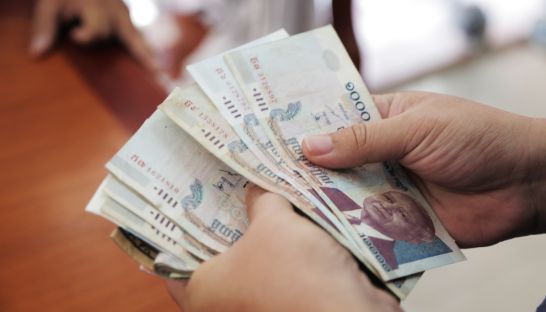US dollar used to curb inflation
US dollar used to curb inflation
Cambodia’s central bank purchased a total of $479.4 million worth of cash during the first half of this year to convert to riel, utilising one of the few tools the National Bank of Cambodia (NBC) has to stabilise the value of the local currency and inject it into circulation, according to the regulator’s latest report.

According to the report, the NBC purchased US dollars 65 times during the first six months of 2017 with an average exchange rate of 4,040 riel per $1. While the value of the local currency has remained stable, the report released on Saturday noted that 60 percent of the additional riel in circulation was absorbed by commercial banks.
Chea Serey, director general of the NBC, said that strong demand from commercial banks reflected an overall confidence in the use of the local currency. However, she noted that the riel’s market share was still dwarfed by a heavy dollarized economy.
“Even though the use of riel is increasing noticeably from previous years, due to the enlargement of our economy, the US dollar still has the biggest share,” she said on Saturday. “Currently, the circulation of US dollar is still at about 83 percent of the currency used in our economy.”
She added that with the central bank having extremely limited options to guide its own monetary policy, the purchase of dollars was needed to maintain a stable exchange rate and to minimise the impacts of inflation.
The central bank predicted that the demand for riel will increase by approximately 18 percent for the rest of 2017 compared to the first half of this year. The value and usage of the riel flows on a cyclical basis, the report noted, rising sharply in March due to the purchase of agricultural products during the harvest season and for tax payments. The riel then begins to decline in April before rebounding again in November and December when rice cultivation picks up.
The report added that the overall balance of payment in US dollar stood at a surplus of 6.5 percent of the annual GDP for the first half of this year, compared to 5.7 percent for the same time last year. Cambodia currently has a foreign exchange reserve of $7.7 billion which could cover up to six months worth of imports.
Mey Kalyan, senior adviser to the Supreme National Economic Council of Cambodia, said that the stable exchange rate and manageable rate of inflation allows for greater use of the local currency, giving the central bank more control over monetary policy.
“A stable exchange rate and inflation rate are indicators that show improvements in the efforts to de-dollarize the economy,” he said.
“The direction [the central bank is heading] is on the right track.”
Kalyan added that a decree published by the NBC late last year that requires all commercial banks and microfinance institutions (MFIs) to hold at least 10 percent of their loan portfolio in riel by the end of 2019 will further strengthen its use in the economy.













